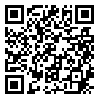Volume 9, Issue 4 (3-2016)
2016, 9(4): 3069-3092 |
Back to browse issues page
1- PhD student of University of Tehran Academic member of Arak University of Technology , rezahmadi@gmail.com
2- Academic member of Isfahan university of technology
3- Academic member of university of Tehran
2- Academic member of Isfahan university of technology
3- Academic member of university of Tehran
Abstract: (5455 Views)
Ground-Penetrating Radar (GPR) is a non-destructive and high-resolution geophysical method which uses high-frequency electromagnetic (EM) wave reflection off buried objects to detect them. In current research this method has been used to identify geometrical parameters of buried cylindrical targets such as tunnel structures. To achieve this aim, relationships between the geometrical parameters of cylindrical targets with the parameters of GPR hyperbolic response have been determined using two intelligent pattern recognition methods known as artificial neural network and template matching. To this goal GPR responses of synthetic cylindrical objects produced by 2D finite-difference method have been used as templates in the neural network and template matching algorithms. The structure of applied neural network has been designed based on extracting discriminant and unique features (eigenvalues and the norm of eigenvalues) from the GPR images and predicting all geometrical parameters of the targets, simultaneously. Also the template matching operation carried out using two diverse similarity approaches, spatial domain convolution and normalized cross correlation in 2D wave number domain. The results of the research show that both two employed intelligent methods can be applied for in situ, real-time, accurate and automatic interpretation of real GPR radargrams, however in general the neural network method has led to less error and better estimation than template matching to predict the geometrical parameters of the cylindrical tar
Keywords: Ground-Penetrating Radar (GPR), Geometrical parameters of cylindrical targets, Artificial neural network, Template matching, Normalized cross correlation
| Rights and permissions | |
 |
This work is licensed under a Creative Commons Attribution-NonCommercial 4.0 International License. |




